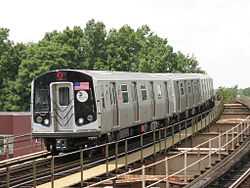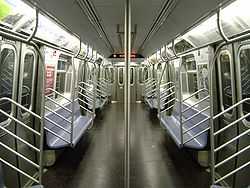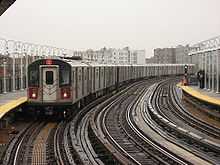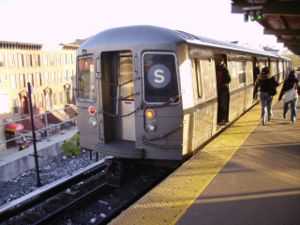R160 (New York City Subway car)
| R160 (New York City Subway car) | |
|---|---|
|
An R160A J train enters 104th Street | |
|
Interior of an R160B in E service on the IND Eighth Avenue Line. | |
| In service | 2006-present |
| Manufacturer | Alstom, Kawasaki Heavy Industries |
| Replaced | |
| Constructed | 2005-2010 |
| Entered service | 2006-2010 |
| Number in service | 1,662 (1,448 in revenue service during rush hours) |
| Formation |
93 four-car sets (two B cars) 258 five-car sets (three B cars) |
| Fleet numbers |
|
| Capacity |
42 seating 198 standing (A car) 44 seating 202 standing (B car) |
| Operator | New York City Subway |
| Depot(s) | Coney Island Yard, East New York Yard, Jamaica Yard[1] |
| Service(s) assigned | |
| Specifications | |
| Car body construction | Stainless steel with fiberglass ends and rear bonnets |
| Train length |
4-car train: 240.84 feet (73.41 m) 5-car train: 301.05 feet (91.76 m) 8-car train (two 4-car sets): 481.68 feet (146.82 m) 10-car train (two 5-car sets): 602.1 feet (183.5 m) |
| Car length | 60.21 feet (18.35 m) |
| Width | 9.77 feet (2,978 mm) |
| Height | 12.13 feet (3,697 mm) |
| Floor height | 3.76 ft (1.15 m) |
| Platform height | 3.76 ft (1.15 m) |
| Entry | 3.76 ft (1.15 m) |
| Doors | 8 pairs per car |
| Articulated sections | 2 to 4 in every car. |
| Maximum speed | 55 mph (89 km/h) |
| Weight | 85,200 lb (38,600 kg) |
| Traction system |
Alstom Onix AC traction model: 4LCA1640A (8313-8842, 9103-9974) Siemens SITRAC AC traction motor (cars 8843-9102) |
| Prime mover(s) | electric motor |
| Power output |
147.5 hp (110 kW) to 150 hp (112 kW) per axle All axles motorized[2][3] |
| Acceleration | 2.5 mph/s (4.0 km/(h·s)) |
| Deceleration |
2.5 mph/s (4.0 km/(h·s)) (full service), 3.2 mph/s (5.1 km/(h·s)) (emergency) |
| Auxiliaries | SAFT 250AH battery (B car) |
| Electric system(s) | 600 V DC Third rail |
| Current collection method | Contact shoe |
| Braking system(s) | Dynamic braking propulsion system; WABCO RT-5 tread brake system |
| Safety system(s) | Dead Man's Handle, Signal-based Tripcock System, emergency brakes, passenger to conductor emergency talk system |
| Headlight type | LED |
| Track gauge | 1,435 mm (4 ft 8 1⁄2 in) standard gauge |
The R160 is a class of 1,662 new technology (NTT) New York City Subway cars built by two different companies: Alstom Transportation and Kawasaki. The class was built by two manufacturers, so they are designated as "R160A" (Alstom) and "R160B" (Kawasaki). The two car types are nearly identical to each other.
Description
The R160A base order was part of a $961,687,121 contract funded in part by a grant from the Federal Transit Administration.[4] The R160s are designed to operate on the New York City Transit Authority's lettered services (B Division), and were intended to replace older subway cars. The primary base order of the R160 class consisted of 660 cars, 400 R160As to be built by Alstom, and the remaining 260 R160Bs to be built by Kawasaki. The contract included options for further orders, which, if exercised, would have brought total business with NYCT to about US$2.4 billion, for 1,700 subway cars, and Kawasaki would have manufactured 40% (680 cars) of the 1,700 cars. The R160 fleet was purchased at an average cost of $1.28 million USD per car.
On November 10, 2008, the MTA exercised options for 140 R160B cars (9803-9942), and 242 R160A cars, broken down into 32 cars arranged as 4-car sets (9943-9974) and 210 cars arranged in 5-car sets (9593-9802). These cars all feature Alstom traction.[5] As of June 2010, all of the R160 cars are in active revenue service.
R160 cars are configured in either 4- or 5-car sets. 372 R160A cars (8313-8652 and 9943-9974) are configured as 4-car sets, maintained at East New York Yard, operating on the BMT Eastern Division J, L, M, and Z services. The remaining 630 R160A cars and all R160Bs are configured as five-car sets for use on IND and BMT main line services. They are maintained at Jamaica Yard, operating on the E and F services, or the Coney Island Yard, operating on the N and Q services.
Kawasaki and Alstom organized a joint venture for project management, engineering and equipment purchasing to pursue the contract. The two companies built and delivered the rolling stock through the joint venture. Kawasaki not only manufactured 260 cars for the base contract, but was also the engineering leader for the whole project and provided the trucks for all cars.
Alstom assembled 1,002 R160A cars at its manufacturing plant in Hornell, New York, while Kawasaki assembled 660 R160B cars at its plant in Yonkers, New York.[6] Shells for the Alstom-built cars were built in their Lapa plant, and shells for the Kawasaki-built cars were assembled at their Lincoln, Nebraska plant.
The R160s have replaced all R38s, R40s, R40As and NYCS R44s as well as most R32s and many R42s.
Features
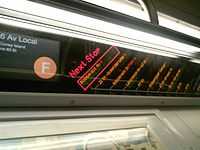
The R160 cars are equipped with the latest control system, HVAC and public address system to guarantee the utmost safety and passenger comfort.
One of the major changes and highlights of the new cars is the addition of an electronic "FIND" (Flexible Information and Notice Display) system, which includes an LCD screen displaying the route, route information and advertisements, and a tri-color (red, yellow, green) LED strip map which displays the next ten stations, plus five consecutive "further stops" to riders. There are three of these in every car. The display updates the stations at every stop, also giving the number of stops to each station listed, and replaces a plastic card which had a set route and stations printed on, which was used on the R142, R142A/S, and R143 cars. This allows for instant route or line changes with the correct information, which includes, but is not limited to, omitting of certain stops.
Both the R160As and R160Bs come with provisions for the future installation for CBTC. However, only 64 R160As (#8313-8376) have been retrofitted with CBTC equipment for operation on the L service alongside trains of CBTC equipped R143 cars.[7]
Problems
Early on in the order, Alstom encountered significant start-up production problems since being awarded the base contract. In July 2005, Alstom missed its contractual deadline to deliver a 10-car test train, which arrived five months late in December, to the New York City Transit Authority. Alstom requested three additional months to deliver the test train. In addition, the Transit Authority rejected several car shells made at their plant in Lapa, Brazil, near São Paulo, after discovering welding defects.[8]
Early on in the order, Alstom was also behind on its delivery schedule. Alstom was to have delivered 200 out of the 400 car base order by September 2007. However, by that month, Alstom had only delivered 80 cars.[9] Under the base contract, Alstom agreed to pay damages of $800 a day for late deliveries of four-car trains, and $1,000 a day for five-car trains. However, the Transit Authority had not yet fined Alstom for its late deliveries and was negotiating with Alstom to accelerate their delivery schedule. The 200 cars were delivered 7 months late in early April.
Differences
Between the R160A and R160B cars
While the two models are almost identical to each other, there are some slight differences between the two car models.
- The R160Bs' door window rims are glossier than those on the R160A.
- With the exception of the first few cars delivered, All later R160As and R160Bs feature thin metal plates around all side windows.
- The R160A doors emit a noticeable whirring sound when they open and close while the R160B doors are silent. This is because the R160As use Vapor door motors while R160Bs use Fuji door motors.
- All R160A traction motors were constructed by Alstom while the R160Bs are split between Alstom traction motors and Siemens traction motors (400 Alstom cars and 260 Siemens cars). These two brands of traction motors have noticeably different sounds. Alstom propulsion (cars 8313-8842, 9103-9974) has stepped sounds while Siemens propulsion (cars 8843-9102) has a smoother, rolling sound. All three sets of cars (R160A, R160B Alstom, and R160B Siemens) are interoperable.[10]
Between the R143 and R160 cars
The R160s are almost identical to the R143s. However, there are differences between the two car models:
- The R143s have standard plastic card route "strip maps", with 64 LEDs in the map,[11] as well as LED advertisements, while R160s have the FIND system, with 15 "next stop" slots, and Arts for Transit cards.
- The American flag on the ends of the A-unit cars is placed above the MTA New York City Subway logo on the R160s, but below it on the R143s.
- The R143s have Bombardier traction motors while most R160s have Alstom traction motors. Some R160Bs have Siemens traction motors.
- The R143s have single storm doors at the blind ends, while the R160s have double storm doors at the blind ends.
- The taillights on the R143s use incandescent bulbs with reflectors while the R160 taillights use LEDs with their characteristic dot-matrix look.
- The rim around the interior LED lights are black on the R160s and white on the R143s.
- The LED side signs are smaller on R143s than they are on R160s.
- The interior paneling of the R143s is a light-teal colored textured material, whereas the R160s feature smooth, glossy white interiors.
- The curved celling molding is thicker and closer together on the R143s than on the R160s.
See also
- R143 (New York City Subway car) - a similar car also built by Kawasaki Railcar Corp. of Kobe, Japan
- R179 (New York City Subway car) - a similar car to be built by Bombardier Transportation.
References
- ↑ New York Subway Barn Assignments
. December 2014 - ↑ Hughes, Murray (2003-01-01). "Subway contract won with help from Brazil". Railway Gazette International.
- ↑ "CIYT201122.jpg Photo by mediccjh | Photobucket". Smg.photobucket.com. Retrieved 2013-08-19.
- ↑ "MTA - Press Release - MTA Headquarters - MTA NYC Transit Awards New Car Contract". mta.info.
- ↑ "Alstom to supply an additional 242 subway cars to New York City". alstom.com. 10 November 2008. Archived from the original on 5 February 2009.
- ↑ MTA Press Release #24 2002
- ↑ "Section IV-3 and section IV-12" (PDF). Mta.info. Retrieved 2013-08-19.
- ↑ Chan, Sewell (2005-07-27). "Damaged Cars Hinder New York's Order for New Subways". New York Times. Retrieved 2009-08-30.
- ↑ Golding, Bruce (2007-09-30). "Train-Car Builder is Off Track". New York Post. Retrieved 2009-08-30.
- ↑ R160 datasheet
- ↑ "The B24 Blog". b24blog.blogspot.com.
External links
| Wikimedia Commons has media related to R160 (New York City Subway car). |
- nycsubway.org: R160 cars
- BMT-IND Car Assignments - December 7, 2014
- New York City Subway Car Fleet June 2010 through June 2014
- National Geographic video about Alstom’s manufacturing of the R160A car on YouTube
| |||||||||||||||||||||||||||||||||||||||||||||||||||||||||||
